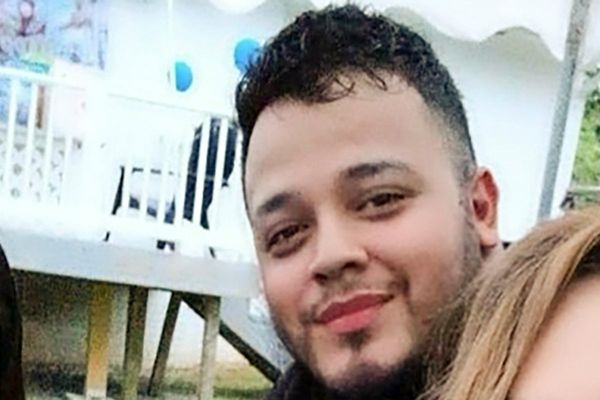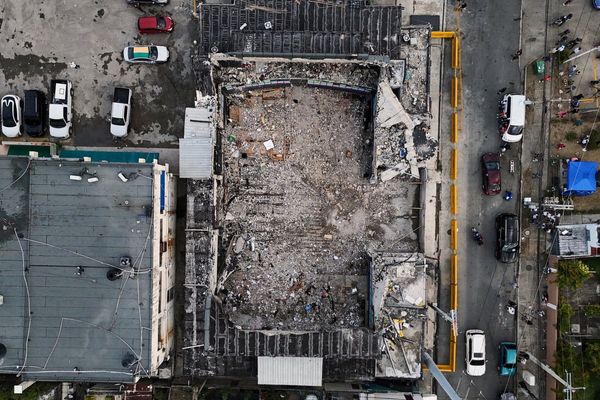CHICAGO — Samira Ahmed was geeking out, speaking fast, excitedly, uncertain where to start, debating both internally and aloud what part of which episode of the Disney+ series “Ms. Marvel” to watch first. “I think we’re going to be here for six hours!” she said, joking.
Or not. I had asked if I could come to her house on the South Side to watch it with her. Because, though “Shang-Chi and the Legend of the Ten Rings” and “Black Panther” became well-known blockbuster watermarks of representation in pop culture, there just hasn’t been a lot of mainstream conversation about the milestone that is “Ms. Marvel.”
Unless you are South Asian and Muslim.
“Oh my god,” Ahmed said, fiddling with the TV remote, scrolling through episodes, “I can’t decide where to begin. They are all great! I mean, this show has been surreal for Desi people — to literally see their lives! On Disney! By Marvel! I doubt anyone could’ve imagined, for a second, to be depicted so well in the most mainstream of mainstream.”
Ms. Marvel — for those still attempting to avoid the Marvel machine — is a hugely beloved, relatively new character, introduced to comics in 2013. In vintage Marvel fashion, by day she is the alliterative Kamala Khan, a Jersey City teenager with cosmic shape-shifting abilities; unlike pal Peter Parker in Queens, she is also Pakistani American and Muslim. And, at least in the TV show, though she is a superhero whose powers didn’t spring from calamity or personal loss (like Superman, Spider-Man and much of hero-dom), she is wrestling with generations of historic colonial trauma, still aligning her personal feelings with Islam and simply trying to be a teenager. And yet, remarkably, with laughs and confidence, the series shakes away the usual self-consciousness, villainy and apology that film and TV often bring to Muslim and South Asian characters. (Indeed, according to a recent study at the University of Southern California, fewer than 2% of speaking roles in movies and TV series go to Muslims.)
Kamala Khan and her traditions are just part of American life.
Since debuting last month, despite the strongest reviews for a Marvel production in years — better than “Black Panther” and “Avengers: Endgame” — “Ms. Marvel” has also had some of the weakest viewership, according to analytic firm Samba TV. Except among Asian, Black and Latino viewers. And Gen Z viewers. When the finale dropped Wednesday, they were ready.
“Everyone I know is watching,” said Junnah Quraishi, a 17-year-old Chicagoan and incoming senior at North Shore Country Day school. “It feels huge. That episode where she travels to Pakistan — I’ve been five times, the whole feel for the place, visiting the grandparent’s house, it was on the screen. And they didn’t make (Kamala) a self-hating Muslim who rejects her culture. She’s in tune with it, but it’s not always a perfect fit. In fact, there are times I wondered if a nonspeaking (Urdu) person would catch all this.”
Bushra Amiwala — a Google employee in Chicago who was elected in 2019 to the board of education for Skokie School District 73.5 (and at 24, thought to be the youngest Muslim elected to office in this country) — has also watched dutifully. As a child, she said she connected with Princess Jasmine in “Aladdin” — “who wasn’t even South Asian, she just looked sort of like me.” But “Kamala, like me, is Pakistani American. I smile now at the kids who get to grow up with the opportunity to see a superhero like them. I mean, even that wedding scene! People assume we don’t get a choice of who we marry, and the emphasis on this whole series has been about personal choice.” She added: “But all of the people I talk to about this show are in the (South Asian and Muslim) community, probably because for so long we had no choice but to watch traditional white heroes. If certain demographics are choosing not to watch because this doesn’t resonate with them — well, it’s just interesting to see what happens when these roles get reversed.”
Americans of Desi backgrounds — that is, of the Indian, Pakistani and Bangladeshi diaspora — are discussing the show in mosque bulletins, via Facebook, DMs, texts.
Ahmed flipped through her phone, reading texts from friends around the world:
“Desi references and Halal Guys jokes — I’m dead.”
“The jokes are A++ and the family dynamics felt so real.”
“‘The ordinariness is what makes it revolutionary.”
She could go on.
Regardless of the reaction to the series, Ahmed would have received a lot of messages. Though she has been widely known for a few years as a writer of young adult novels featuring brave South Asian protagonists, since December she’s also been writing the “Ms. Marvel” comic books. Last weekend, when she was at her family’s home in Batavia for the Muslim holiday Eid al-Adha, her parents and relatives gathered around the TV to watch the series together. “They should say, ‘Look, that’s Samira’s character’ And I would have to say, ‘No, no, I didn’t create her and I didn’t write the TV show. I just do the comics.’ But they would come back, so proud, ‘Yes, but still, that is your character!’”
She fast-forwarded to a scene in the first episode.
Kamala is about to take her driver’s test. Her brother — who had just been introduced while saying prayers before eating — reminds her casually to say bismillah (loosely, “in the name of God”) before starting the car. She whispers it, then backs into a parked car.
“That is so spot-on,” Ahmed said. “Exactly what my father would say. We would say it together as a family before we would back out of the driveway. My dad, watching, was like, ‘See! I told you!’ He felt so vindicated. It’s on TV, now it’s legit! He’s in his 70s and I would watch him watching and every time a character would say an Urdu word, he would repeat it. In Urdu poetry, there is a tradition among Indians to repeat lines of the poet, and that’s what he was doing. My parents were completely relating and nodding.”
She smiled.
“The (Desi) soundtrack alone! I have never watched my parents sing along with an American TV show before.”
She flipped to Episode 5.
It begins with a black-and-white newsreel explaining the 1947 partition of India by the British into two countries, India and Pakistan; indeed, if there’s trauma at the heart of this superhero saga, it revolves around this historic cataclysm, which broke up families, displacing whole regions, often along religious lines. The show gives them a suitably epic David Lean-like scope, full of rail yards packed with people fleeing and clinging. Through events best explained by Marvel machinations, Kamala time travels back there.
Ahmed paused the show and curled one leg of her torn jeans under the other.
“So half of my family is in Pakistan and half is in India, and my jaw was on the floor when I saw this. I remember talking to my grandmother about it and she was like, ‘I was born in India and I will die in India,’ so she would not leave during the partition, which was hard because they were Muslim and there was so much sectarian violence stoked by colonialism. Every Pakistani family has a partition story. And here they are talking about the principles of colonialism, which are divide and conquer. And it makes British colonialism an official Marvel villain in a way. I thought I would faint when I saw this. Nobody knows partition here! The study of history in American school barely leaves American borders.”
She shook her head in amazement.
Tanvi Arora, who is 34 and Indian and Punjabi and lives in the South Loop, echoed this. She watches after she gets her 3-month-old to sleep. “Partition is such a touchy subject in the community I would never have dreamed of seeing it in mainstream Western cinema. Never mind how they made it authentic and thoughtful. Trust me, you have no idea how infuriating it’s been to watch Apu on ‘The Simpsons’ all these years.”
In American grade school, the last thing Sabrina Lakhani, now a relationship coach in Chicago, wanted anyone to know was that she was Pakistani. “So it’s intriguing how much this next generation wants to be recognized as different. People will understand us in a new way because of a show like this.”
As a professional, her specialty is attachment — namely, the patterns that emerge between children and parents. She said the way the show depicts the tensions between the teen Kamala and her progressive-yet-traditional parents feel honest. “(Her mother) asks Kamala to decide who she wants to be — good or someone with their head in the clouds. Which of course is true of a lot of parental relationships, but in a South Asian household, it can get framed that rigidly.”
At the heart of Kamala Khan is a young girl deciding what her values are, where religion fits (and doesn’t) into her life and how generations of heartache dovetail with her story. She is not the first Muslim character in the Marvel universe, but the first written with layers. Ahmed was reading her adventures for years before writing for Marvel.
Ahmed was born in Mumbai (formerly Bombay) and grew up in Batavia. Her family were the first South Asians to move there. They came in 1972. By 1977 there were enough Muslims in the Batavia area to create a small mosque. So the Ahmeds started one in their home, with a handful of families. “We would move aside the dining table, put out prayer rugs. People came during lunch. It grew to like 30-40 people.” They moved into an old Boy Scout lodge, then were offered unused space in the Calvary Episcopal Church of Batavia. That space eventually became the (still-operating) Batavia Islamic Center.
In “Ms. Marvel,” Kamala’s local mosque is never far from her life. But then neither are the quirks, stresses and everyday trials of being a teenager. Kamala loudly complains to an imam, during service, that the women’s section is not as well maintained as the men’s. After service — it is traditional to remove shoes in the prayer area of a mosque — she can’t find her shoes. Talking to Desi fans of “Ms. Marvel,” you hear again and again how loving the show has been with such details — a benefit of having a series almost entirely created by a South Asian cast, with South Asian writers and directors for each episode.
For instance, there’s the way Kamala doesn’t wear a hijab but her best friend does; according to a Pew Research Center survey in 2017, of the 1 million Muslim women in the United States, less than half wear a hijab in public. And there’s the way shop owners and dressmakers speak mostly Urdu to Kamala’s parents and then switch to English when speaking to the young Kamala.
In fact, that last detail might be the most revolutionary.
Most of the Urdu in “Ms. Marvel” is not translated or even given subtitles. It just exists in the world, for you to know or not know (however, this being friendly, broad-reaching Marvel, meanings are often clear).
“I love that,” Ahmed said. “Slipping in and out of Urdu and English is how we talk and it’s often the mark of a child of immigrants, and the show doesn’t exoticize any of that. It braids together identities. I am Indian and the oldest kid of immigrants and Muslim and American and I speak Urdu. We don’t exist in silos. But then that’s how diaspora works.”
———







